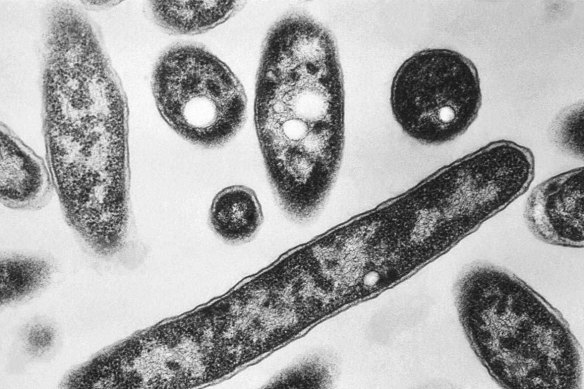By Jewel Topsfield and Henrietta Cook
A cooling tower in Melbourne’s west has been identified as the probable source of the Legionnaires’ disease outbreak that has killed two Victorians and spread to almost 90 cases.
Victoria’s Chief Health Officer, Clare Looker, said tests had revealed a Laverton North cooling tower was likely behind the 78 confirmed and 10 suspected cases of the disease, the state’s worst outbreak in more than two decades.

The Legionnaires’ bacterium.Credit: AP
“I can confirm that one of the towers we’ve tested and which was subsequently disinfected early in our investigation has returned a positive Legionella sample,” Looker said.
“This gives us increased confidence that we have identified and already treated the source of this outbreak.”
This latest outbreak of Legionnaires’ disease is the most significant since one at the Melbourne Aquarium in 2000 led to 150 people falling sick and four people dying.
Looker refused to identify the exact location of the Laverton North cooling tower, other than it was on a big site, because the investigation was still active.
She said the cooling tower had a good history of compliance with testing and audit requirements and had a risk-management plan in place.

Victoria’s Chief Health Officer Clare Looker.Credit: AAP
“Of course, we’ll maintain an open mind as to whether there might have been a breakdown in process but I think until we have further details around that, it’s probably tricky to speculate on what the next steps would need to be.”
The Department of Health is working closely with the operator of the cooling tower to understand what might have happened to allow the Legionella to grow.
Looker said most cases continued to be adults aged over 40. About 75 of the confirmed cases and eight of the suspected cases had been hospitalised.
“I’m confident that we have now passed the peak of the cases associated with this outbreak,” she said.
Legionnaires’ disease usually presents as a chest infection, with symptoms such as fever, chills, cough, headache and muscle aches and pains.
It is spread by breathing in fine droplets of water that contain Legionella bacteria. It is not commonly spread from person to person or by drinking contaminated water.
In this outbreak, most cases have been in people who are normally at greater risk of the infection, but there have also been cases in otherwise healthy adults.
Looker said the cooling tower was visited early in the Health Department’s investigation — on July 30 — and disinfected within 24 hours of that visit.
Inspection teams have now visited and tested 54 high-priority sites in the area and had disinfection requested.
“The team has again been on site today at the tower where this positive sample was identified,” Looker told reporters on Monday. “They’re conducting further investigations and a further precautionary disinfection.”
Cooling towers are structures used to remove excess heat from a building or industrial process by cooling a water stream to a lower temperature. They are commonly used in power plants, industrial facilities and heating ventilation and air-conditioning systems.
Authorities believe Melbourne’s chilly weather this season fuelled the spread of the disease by creating patterns of thermal inversion, which causes air to spread further at lower levels.
A Bureau of Meteorology spokesman confirmed the agency had provided weather information to the Health Department to assist with its investigation into the outbreak.
Associate professor Sanjaya Senanayake, an infectious diseases physician at the Australian National University, warned case numbers could continue to rise due to the disease’s incubation period, which ranges from two to 10 days.
“Once the infected towers have been cleaned, we shouldn’t expect to see any new cases,” he said.
Senanayake said the Legionella bacteria could thrive in warm water in cooling towers, which is why they were regularly monitored.
Looker said that as the cause of the Legionnaires’ outbreak was yet to be identified, it was difficult to say what remediation steps would be necessary.
“We do have very robust management of cooling towers,” she said. “As well as looking at this site specifically, we’ll also be looking at ... any improvements we can make to the current system.”
The Morning Edition newsletter is our guide to the day’s most important and interesting stories, analysis and insights. Sign up here.